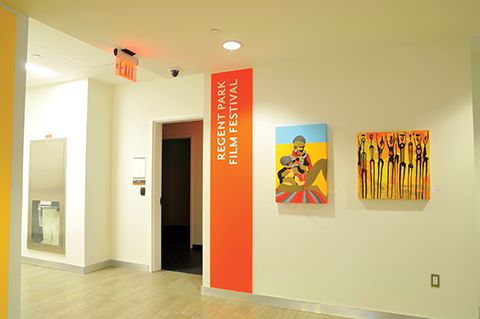By Udo Schliemann
‘Placemaking’ is the act of making
a space one’s own. This may seem obvious and logical with relation to people in their homes, but it becomes more of a challenging task for graphic designers, signmakers, architects, planners and other designers when it is applied to public spaces, large workplaces, hospitals, educational environments and large transportation hubs like airports.
The public is probably most familiar with the concept of placemaking for theme parks, like Canada’s Wonderland and Walt Disney World, as well as sports arenas, where the environment has been purposefully designed to excite and entertain the audience. Elsewhere, however, the need for placemaking may seem less apparent.
Given today’s trends of globalization, dependence on technology speed of communication and transportation, there has been an emphasis in modern societies—particularly in bustling cities—on the aspects of mobility, flexibility and functionality in human life. This emphasis has reflected a culture of restlessness, which can make it more difficult than in the past to build a sense of place and community.
The combination of efficiency, progress and economic growth has been a tremendous success story, creating a world of unprecedented wealth and abundance, but has also involved unsustainable development and a neglect of people’s well-being. Consider the common example of employees working long hours in drab, grey offices.
With technological advances, especially ubiquitous computing, there has been a reorientation of how people live, play and work. Now, a focus on urbanity is renewing an emphasis on place—including how to improve the visual appeal of spaces where people live, play and work.
Signmakers often assume this task is the job of architects, but this is only a partial answer. Architects aim to create spaces that are functional and help people interact and feel comfortable, based on how spaces are organized, how light streams into buildings and which materials are chosen, among other examples, but in general, they do not handle aspects of communications within a building. Rather, signmakers and other designers provide the wayfinding, orientation, branding and artwork that are added as the last ‘layers’ to a building’s sense of place and identity. These layers represent the field of environmental graphic design (EGD), which looks well beyond the sign panel.

Wall graphics and translucent space dividers bring colour to previously grey working spaces in RBC Tower.
Opportunities for signmakers
With respect to the aforementioned example of offices, today’s multinational, high-tech, service-oriented and consulting companies that typically operate in large towers have recognized a need to move from traditionally hierarchical structures to ‘agile’ work environments to support greater innovation. As they have noticed, a better-designed built environment—with variable workplace configurations—can improve internal communications and employee performance.
Such changes are also driven by today’s young workforce, innovation-centric business models and disruptive technologies. Physical designs are being informed by how data and social media have triggered a revolution in organizational structures. Not only offices, but also laboratories, research facilities, libraries, educational buildings, community centres and even transit hubs have seen the same eagerness to build a sense of place, authenticity and belonging.






